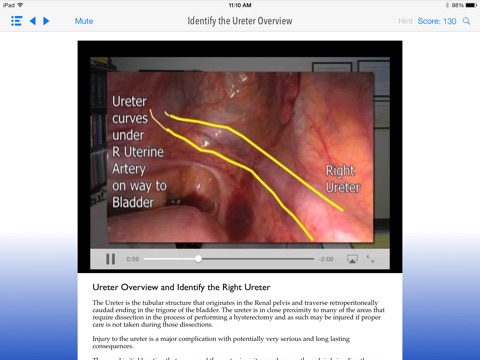
SimPraxis Lap Hysterectomy Trainer app for iPhone and iPad
Developer: Red Llama, Inc.
First release : 17 Nov 2013
App size: 758.45 Mb
Accelerate your surgical training—increase your confidence and competency in performing the Total Laparoscopic Hysterectomy (TLH) procedure by significantly increasing your cognitive knowledge and understanding. The self-paced SimPraxis® Total Laparoscopic Hysterectomy Trainer is a robust, elegant and engaging way to learn.
This SimPraxis TLH iPad app is an interactive professional-level surgical simulation trainer. Divided into 7 modules, it is designed to significantly advance your surgical knowledge, efficiency and competency. Ideal for the entire surgical team: surgeons, residents, surgical technologists & surgical assistants. This cognitive trainer employs operating room video, interactive simulation, animation, and complete formative tracking and summative scoring in order to provide meaningful and accurate self-assessment.
Your learning objectives using this SimPraxis TLH Trainer include:
• Specific surgical steps of the hysterectomy procedure
• Key operative decision-making and judgment
• Respective roles of the surgeon and assistant
• Relevant anatomy
• Key surgical risks at each step
• Port placement
• Key surgical variations
• Appropriate instruments
• Pre- & post-op considerations
Module 1: Comprehensive Introduction to TLH
Quickly build your competency and confidence on the laparoscopic approach to hysterectomy. This SimPraxis base application includes: Intro to Training; Intro to the Laparoscopic Hysterectomy Procedure; Overview of Surgical Instruments; Interactively Select Instruments; Patient Positioning; Placement of Uterine Manipulator; Overview of Triple Pedicle and Broad Ligament Surgical Steps; Interactively Transect the Right Round Ligament; Round Ligament Anatomy Quizzes; Overview of Fallopian Tube and Utero-ovarian Ligament; Triple Pedicle Risks.
Tailor your individual training with these available In-App Purchases:
Module 2: Critical Anatomy & Port Placement
Critical Anatomy and Port Placement options for the TLH procedure are taught in this module. The anatomy instruction and quizzes in this Trainer include: the initial upper abdominal and pelvic anatomy surveys; identifying the ureters; round, utero-ovarian, IP, broad and cardinal ligaments; fallopian tubes; bladder, rectum, and the uterine vasculature. The Hasson and Veress port access techniques are also described.
Module 3: Operate 1: Triple Pedicle
This module covers the Role of the Surgeon and Assistant, the specific procedure steps in the TLH; interactively transect the round ligaments, incise the broad ligament, fallopian tubes, utero-ovarian ligaments, mesosalpinx, and dealing with pelvic sidewall adhesions. Anatomy and procedure step quizzes are also provided.
Module 4: Operate 2: Retroperitoneal Dissection, Uterine Vasculature, & Vaginal Cuff
An overview of the retroperitoneum dissection is provided before interactively: Identifying the ureters, opening the peritoneum, creating the bladder flap, skeletonizing the uterine vasculature and cardinal ligaments, & creating the vaginal cuff. Anatomy and procedure step quizzes also provided.
Module 5: Operate 3: Removal of Uterus & Suturing
Methods for removing the uterus are discussed and shown in this module. You will interactively learn suturing and alternate techniques for closing the cuff. Testing for hemostasis and use of the pneumo-occluder are also discussed. Quizzes are also provided.
Module 6: Operate 4: Irrigate, Survey, Port Site Closure, & Post-Op
Irrigate, survey, port site closure and post-operative care are extensively discussed in this module. How to control uterine artery bleeding, cystoscopy and recto-sigmoid assessment are also reviewed and demonstrated. Quizzes are also provided.
Module 7: Risks & Adhesions
The potential errors, patient injury and medical complications at each procedure step are reviewed and discussed throughout this module. In addition, umbilical omental, rectal, and appendiceal adhesions are presented.



